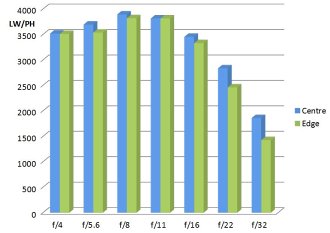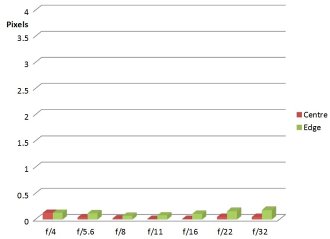Nikon PC Nikkor 19mm f/4 E ED Review
Nikon PC NIKKOR 19mm f/4E ED Performance
Sharpness throughout is of a very high order. Centrally, results are excellent from f/4 to f/16, still very good at f/22 but soft at f/32. The edges match the centre very well, delivering virtually identical resolution figures. Results are again excellent from f/4 to f/16, softening at f/22 and especially at f/32. The even performance is very important in this lens as it uses its wider image circle to enable shift movements. It covers a field of view far wider than the one actually used in an image when the lens is centred.
How to read our MTF charts
The blue column represents readings from the centre of the picture frame at the various apertures and the green is from the edges.The scale on the left side is an indication of actual image resolution as LW/PH and is described in detail above. The taller the column, the better the lens performance.
For this review, the lens was tested on a Nikon D810 using Imatest.
CA (Chromatic Aberration) is not a problem at all. The figures obtained are so low as to make CA totally insignificant. This is an exemplary performance.
How to read our CA charts
Chromatic aberration (CA) is the lens' inability to focus on the sensor or film all colours of visible light at the same point. Severe chromatic aberration gives a noticeable fringing or a halo effect around sharp edges within the picture. It can be cured in software.Apochromatic lenses have special lens elements (aspheric, extra-low dispersion etc) to minimise the problem, hence they usually cost more.
For this review, the lens was tested on a Nikon D810 using Imatest.
Flare is mostly well under control. Even shooting directly into the sun the lens is free from artefacts and maintains its contrast level without difficulty. It is possible to induce some contrast lowering flare when the light hits some oblique angles, but for most situations, it was not visible.
Distortion is low at -1.16% barrel, and can always be enhanced by removing this small amount in software.
Bokeh and wide angle lenses do not necessarily go hand in hand, but it is true that here the bokeh does seem to be rather smooth and pleasant. This may not be as immediately obvious as with a telephoto lens, but it does have an effect and will certainly improve the overall feel of images.
Value For Money
The PC Nikkor 19mm f/4E ED lens is priced at £3299, a not insubstantial sum of money. If we compare it with a medium format option, then that looks good against the Hasselblad HTS 1.5x Tilt and Shift Adapter at £4212, although to be fair that enables tilt and shift with a number of different lenses.
There are other Nikon PC lenses, the 24mm f/3.5D ED PC-E (£1569), 45mm f/2.8D PC-E (£1459) and the 85mm f/2.8 D PC-E Micro Nikkor (£1349).
Canon users have the options of the TS-E 24mm f/3.5 L II (£1689), TS-E 17mm f/4 L (£1999), TS-E 90mm f/2.8 (£1239) or TS-E 45mm f/2.8 (£1199).
Samyang have the T-S 24mm f/3.5 ED AS UMC at £679, which has its low price and a variety of mount options going for it. It is available for Nikon, Canon, Sony Alpha and FE mount and Pentax K. The other low cost option is the Lensbaby Edge 80.
As this is the only ultra-wide option for Nikon users, the value for money aspect is largely academic, and it is a case of if we need the lens then we hire or face the cost of buying. What is certain is that in terms of quality it justifies its price tag.
For more options have a look at the Top 10 Best Nikon Lenses or the Top 15 Wide-angle Landscape Lenses.
Add your message
Please login here or if you've not registered, you can register here. Registering is safe, quick and free.
photodo Stats
428 MTF tests
74 in-depth photodo reviews
100+ users join each day
Help the lens community by reviewing or rating a lens today via our lens search
Latest Lens Reviews
- Chinon 28mm f/2.8 Vintage Lens Review
- Canon EF 70-200mm f/4L IS II USM Lens Review
- Samyang AF 85mm f/1.4 EF Review
- Sigma 70mm f/2.8 DG Macro Art Review
- Samyang AF 24mm f/2.8 FE Review
- Meike 50mm f/1.7 Review
- Tamron 70-210mm f/4 Di VC USD Review
- Lensbaby Burnside 35mm f/2.8 Review
- Asahi Super Takumar 50mm f/1.4 Review
- Asahi Super-Multi-Coated Takumar 135mm f/3.5 Review


